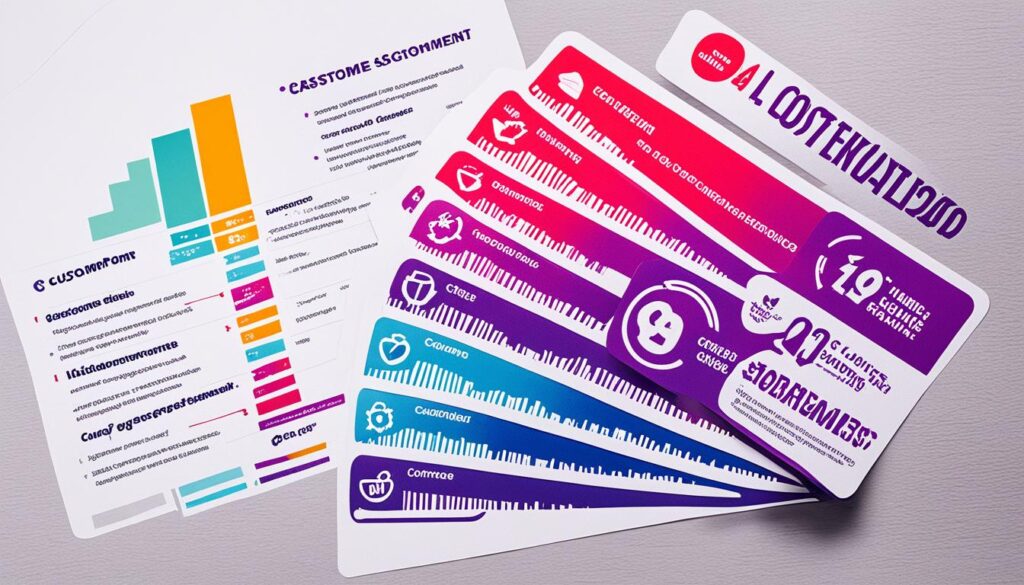Welcome to our blog post on customer loyalty programs! In today’s competitive business landscape, retaining customers is vital for sustainable success. Customer loyalty is the key to long-term profitability and growth. By implementing effective customer loyalty programs, you can maximize customer retention and propel your business forward. Let’s explore the benefits, strategies, and examples of loyalty programs that can help you build strong customer relationships and boost your bottom line.
Customer loyalty programs are designed to reward and incentivize customers for their repeat purchases and continued patronage. These programs not only increase customer retention but also foster brand advocacy and customer engagement. By offering benefits, discounts, points, or exclusive perks, businesses can create a sense of value, appreciation, and exclusivity for their loyal customers.
With a well-executed loyalty program, you can increase customer lifetime value by encouraging higher spending, frequent purchases, and long-term loyalty. Moreover, loyalty programs enable businesses to gather valuable customer data, personalize the customer experience, and strengthen customer relationships.
Throughout this blog post, we will delve into the importance of customer retention, the role of loyalty programs in boosting customer lifetime value, effective loyalty program design strategies, real-life examples, and the influence of technology in loyalty program management.
So, whether you’re a small business owner or a marketing professional, this blog post will provide you with valuable insights and practical tips to develop and optimize your customer loyalty programs. Let’s get started on the journey to maximizing customer retention and loyalty!
The Importance of Customer Retention
Customer retention is a vital aspect of any successful business strategy. By focusing on keeping your existing customers satisfied and engaged, you can achieve higher customer lifetime value and maximize your profitability. Implementing a well-designed loyalty program is a powerful tool to drive customer retention.
With a loyalty program, you can reward your customers for their loyalty and encourage them to continue doing business with you. By offering exclusive discounts, personalized rewards, and other loyalty incentives, you can create a sense of value and appreciation among your customers.
Moreover, a loyalty program provides opportunities for customer engagement. Through personalized experiences and interactions, you can build stronger relationships with your customers. By understanding their preferences and needs, you can tailor your offerings to meet their expectations, enhancing their overall experience with your brand.
Engaging Customers Through Personalization
Personalization is a key component of a successful loyalty program strategy. By collecting and analyzing customer data, you can gain valuable insights into their shopping habits, preferences, and interests. This data allows you to create personalized offers and recommendations, making your customers feel understood and valued.
Additionally, a well-implemented loyalty program provides you with valuable customer data for predictive analytics. By analyzing their behavior and purchase patterns, you can anticipate their future needs and proactively engage with them, further strengthening the customer-business relationship.
Reducing Customer Churn Through Loyalty Programs
Customer churn, or the loss of customers, can be detrimental to your business. A loyalty program acts as a powerful tool to reduce churn by incentivizing customers to stay engaged and committed to your brand. Through exclusive rewards, tiered benefits, and special offers, you can create a sense of exclusivity and loyalty among your customers, making it less likely for them to switch to your competitors.
Furthermore, the customer data obtained through a loyalty program allows you to identify at-risk customers and implement targeted retention strategies. By reaching out to these customers with personalized offers or support, you can address their concerns and further solidify their loyalty.
Customer Satisfaction and Engagement
Implementing a loyalty program not only enhances customer satisfaction by providing tangible rewards and benefits but also fosters a deeper sense of engagement. By actively participating in your loyalty program, customers feel more connected to your brand and become more likely to refer your business to their friends and family.
Ultimately, customer retention is the foundation for long-term success, and a well-executed loyalty program is a key component of any customer retention strategy. By offering rewards, personalized experiences, and addressing customers’ needs, you can build strong relationships that lead to increased customer loyalty and satisfaction.
| Loyalty Program Benefits | Customer Engagement | Loyalty Rewards | Loyalty Program Strategy |
|---|---|---|---|
| Incentivizes repeat purchases | Creates personalized experiences | Offers exclusive discounts | Aligns with business goals |
| Builds stronger customer relationships | Collects valuable customer data | Provides personalized rewards | Segmentation and targeting |
| Reduces customer churn | Customizes offerings based on preferences | Encourages loyalty through tiered benefits | Measures program effectiveness |
| Increases customer lifetime value | Predicts and anticipates customer needs | Fosters customer engagement | Drives customer satisfaction |
Implementing a well-designed loyalty program as part of your customer retention strategy can have a significant impact on the success and growth of your business. By keeping your customers satisfied, engaged, and rewarded, you can build long-lasting relationships and maximize their lifetime value.
Boosting Customer Lifetime Value with Loyalty Programs
Loyalty programs are powerful tools that can significantly impact the customer lifetime value of your business. By implementing an effective loyalty program, you can encourage customers to spend more, make purchases more frequently, and stay engaged over the long term. Rewards, discounts, and other perks can incentivize customers to increase their average order value, purchase more often, and remain loyal for a longer duration.
One of the key benefits of loyalty programs is their ability to facilitate cross-selling and upselling opportunities. By offering personalized recommendations or exclusive offers, you can encourage customers to explore and purchase complementary products or upgrade to higher-tier options. This not only increases their overall spend but also enhances their overall customer experience.
Additionally, loyalty programs can generate referrals and promote word-of-mouth marketing. When customers feel valued and rewarded for their loyalty, they are more likely to recommend your business to family, friends, and colleagues. This organic form of marketing can help expand your customer base and increase brand awareness, all while driving customer retention and loyalty.
“I love the loyalty program at XYZ Apparel. The more points I earn, the more discounts I get on my future purchases. It keeps me coming back for more, and I’ve also told my friends about it!”
– Lisa Smith, XYZ Apparel loyal customer
An effective loyalty program can significantly contribute to the overall profitability of your business. By increasing customer lifetime value, you can maximize the return on your marketing efforts and resources. Customers who are engaged and loyal are more likely to continue purchasing from your business, reducing customer churn and improving the stability of your revenue streams.
Customer Testimonials:
- “The loyalty points system at ABC Supermarket encouraged me to shop there more frequently. I love redeeming my accumulated points for discounts on groceries!” – Mark Johnson, ABC Supermarket customer
- “The loyalty card program at XYZ Coffee Shop keeps me coming back for my daily caffeine fix. The free coffee I earn after a certain number of purchases is always a great perk!” – Sarah Miller, XYZ Coffee Shop customer

| Loyalty Program Benefits | Customer Retention | Loyalty Card Programs |
|---|---|---|
| Incentivizes customers to spend more | Encourages repeat purchases | Offers exclusive perks and rewards |
| Increases average order value | Reduces customer churn | Improves customer satisfaction |
| Boosts customer engagement | Generates referrals | Promotes word-of-mouth marketing |
Designing Effective Loyalty Programs
When it comes to loyalty programs, a well-designed strategy is key to maximizing customer engagement and reaping the benefits. Designing an effective loyalty program requires careful consideration of your business goals and customer needs.
To create a successful loyalty program, it’s essential to ensure that it is relevant, valuable, and appealing to your target audience. Aligning the program with your brand identity and values helps to strengthen your overall brand perception and maintain consistency.
One crucial aspect of a successful loyalty program is simplicity and transparency. Customers should easily understand the rules and how they can earn and redeem rewards. This transparency builds trust and encourages active participation.
Personalization is another powerful tool to enhance customer engagement with your loyalty program. Tailoring rewards and offers based on individual preferences and buying behavior makes customers feel valued and understood. This level of personalization fosters a deeper connection with your brand.
Gamification is an effective technique for increasing customer engagement within your loyalty program. Adding interactive elements such as challenges, competitions, and rewards-based progress can make the program more enjoyable and encourage customers to keep coming back for more.
Segmentation is a key strategy for catering to different customer segments within your loyalty program. By dividing your customer base into specific groups based on demographics, purchase behavior, or other relevant factors, you can customize offers and rewards to meet their unique needs and preferences.
To ensure the ongoing success of your loyalty program, tracking and measuring its performance is crucial. Monitoring customer retention, lifetime value, and other key metrics allows you to evaluate the program’s effectiveness and make data-driven improvements. Collecting customer insights and feedback enables you to continuously optimize and enhance the program based on their preferences and expectations.
Benefits of Designing an Effective Loyalty Program:
- Increased customer engagement and satisfaction
- Higher customer retention rates
- Boost in average order value and purchase frequency
- Improved brand loyalty and advocacy
- Access to valuable customer data for personalization and targeted marketing
Designing an effective loyalty program requires a strategic approach that takes into account your business goals as well as the needs and preferences of your customers. By focusing on relevance, value, simplicity, personalization, gamification, segmentation, and tracking, you can create a loyalty program that drives customer engagement and delivers long-term benefits.

Note: The image above showcases the various benefits of loyalty programs, such as increased customer engagement and satisfaction, higher retention rates, and improved brand loyalty. Keep these benefits in mind when designing your own loyalty program to achieve similar results.
Examples of Loyalty Programs in Action
There are different types of loyalty programs that businesses can implement to increase customer retention and loyalty. Let’s explore some examples to understand how these programs work and the benefits they offer:
Point-based Programs
A common and straightforward loyalty program is the point-based program. In this program, customers earn points for their purchases. These points can then be redeemed for rewards such as discounts, free products, or exclusive access to events or promotions. Point-based programs incentivize customers to keep coming back and making repeat purchases to accumulate more points and unlock greater rewards.
Tier-based Programs
Tier-based loyalty programs offer different levels of benefits based on customer spending or activity. Customers start at a base level and can progress to higher tiers by reaching specific milestones, such as spending a certain amount or making a certain number of purchases. Each tier offers increased rewards, exclusive perks, and personalized experiences. Tier-based programs create a sense of achievement and provide motivation for customers to strive for higher levels of loyalty.
Subscription-based Programs
Subscription-based loyalty programs require customers to pay recurring fees in exchange for exclusive benefits. For example, a beauty retailer may offer a monthly subscription that provides customers with early access to new products, personalized recommendations, and free samples. Subscription-based programs not only generate recurring revenue for the business but also foster a sense of community among subscribers and create a loyal customer base that values the ongoing benefits they receive.
Value-based Programs
Value-based loyalty programs align rewards with customers’ values or causes. For instance, a clothing brand may pledge to donate a percentage of each purchase to a chosen charity or plant a tree for every item bought. Value-based programs appeal to customers who are socially conscious and want their purchases to make a positive impact. By connecting loyalty to a higher purpose, businesses can build deeper emotional connections with customers and foster loyalty based on shared values.
Implementing the right loyalty program can incentivize customer loyalty and drive repeat purchases. Different programs suit different businesses and customer demographics, so it’s important to consider the target audience and their preferences when designing a loyalty program.

| Loyalty Program Type | Benefits |
|---|---|
| Point-based | – Earn points for purchases |
| – Redeem points for rewards | |
| – Motivates repeat purchases | |
| Tier-based | – Different levels of benefits based on spending or activity |
| – Increased rewards and perks at higher tiers | |
| – Creates a sense of achievement and loyalty | |
| Subscription-based | – Recurring fees for exclusive benefits |
| – Generates recurring revenue | |
| – Fosters a sense of community | |
| Value-based | – Rewards aligned with customers’ values or causes |
| – Appeals to socially conscious customers | |
| – Builds emotional connections based on shared values |
The Role of Technology in Loyalty Programs
Technology plays a crucial role in the successful design and implementation of loyalty programs. By harnessing the power of technological tools, businesses can enhance their loyalty program strategy, effectively manage customer engagement, and optimize loyalty rewards to maximize customer retention and lifetime value.
One key technological component that significantly contributes to loyalty management is the use of Customer Relationship Management (CRM) tools. These tools enable businesses to efficiently analyze customer data, gain insights into customer behavior and preferences, and personalize the customer experience. With CRM tools, businesses can track customer interactions, tailor marketing messages, and predict future customer needs, ultimately driving customer engagement and loyalty.
Another valuable technological solution for loyalty programs is the implementation of customer data platforms (CDPs). These centralized platforms gather and integrate customer data from multiple sources, such as purchase history, demographics, and online behavior. By consolidating customer data, businesses can create a comprehensive view of each customer, enabling personalized marketing campaigns, targeted promotions, and tailored loyalty rewards. CDPs empower businesses to deliver a seamless and personalized customer experience, enhancing customer engagement and satisfaction.
Marketing automation tools also play a vital role in loyalty program management. These tools allow businesses to automate marketing actions within loyalty programs, such as sending personalized emails, targeted offers, and timely notifications. Automation streamlines and optimizes loyalty program operations, ensuring consistent and timely communication with customers. By leveraging automation technology, businesses can improve efficiency, increase customer engagement, and drive loyalty program success.
Advanced analytics is another area where technology greatly supports loyalty program strategy. By utilizing data-driven insights, businesses can measure the effectiveness of their loyalty programs, identify areas for improvement, and make data-informed decisions. Analytics provide valuable information on customer behavior, program performance, and the overall impact on customer retention and lifetime value. Armed with this knowledge, businesses can refine their loyalty program strategy, optimize rewards, and continuously enhance the customer experience.
To summarize, technology is an indispensable asset in loyalty program management. CRM tools, CDPs, marketing automation, and advanced analytics enable businesses to implement effective loyalty program strategies, drive customer engagement, and foster long-term customer loyalty. By embracing the right technological solutions, businesses can execute loyalty programs that resonate with customers and contribute to increased customer lifetime value.
Conclusion
Customer loyalty programs are powerful tools for increasing customer retention and maximizing customer lifetime value. By implementing an effective loyalty program, your business can create a compelling incentive for customers to stay loyal and continue making repeat purchases. These programs not only reward customers for their loyalty but also help build stronger relationships and reduce customer churn.
With the right loyalty program strategy, you can significantly impact customer lifetime value. By offering rewards and incentives, you can increase the average order value and purchase frequency of your customers. Additionally, a well-designed loyalty program can extend the duration of the customer relationship, ensuring long-term customer loyalty.
To ensure the success of your loyalty program, it is important to consider the right technology and strategies. By leveraging customer relationship management (CRM) tools, you can analyze customer data, personalize the customer experience, and predict customer behavior. Technology solutions like customer data platforms (CDPs) and marketing automation tools can help streamline and optimize your loyalty program.
By implementing a customer loyalty program that aligns with your business goals and customer needs, you can drive customer loyalty, improve profitability, and enhance the overall customer experience. So, invest in loyalty marketing and management to unlock the full potential of your customer relationships.
FAQ
What is customer loyalty?
Customer loyalty is the decision of a customer to continue purchasing from a particular business based on factors such as product quality, customer experience, and price.
Why is customer retention important?
Customer retention is crucial for businesses as it is more cost-effective than acquiring new customers. Retaining existing customers and increasing customer loyalty can lead to higher customer lifetime value.
How can loyalty programs boost customer lifetime value?
Loyalty programs have the potential to increase customer lifetime value by encouraging customers to spend more, purchase more frequently, and stay engaged over the long term.
How can businesses design effective loyalty programs?
Designing effective loyalty programs requires careful consideration of business goals and customer needs. Loyalty programs should be relevant, valuable, and appealing to the target audience, align with the brand identity and values, and have simple and transparent rules.
What are some examples of loyalty programs in action?
Loyalty programs can take various forms, such as point-based programs, tier-based programs, subscription-based programs, and value-based programs.
What role does technology play in loyalty programs?
Technology plays a crucial role in the design and implementation of loyalty programs. Customer relationship management (CRM) tools, automation software, centralized customer data solutions, and marketing automation tools are some examples of technology that can optimize loyalty programs.
